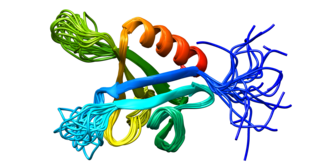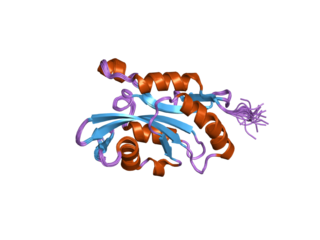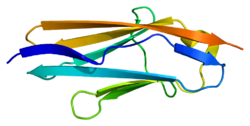
Titin is a protein that in humans is encoded by the TTN gene. Titin is a giant protein, greater than 1 µm in length, that functions as a molecular spring that is responsible for the passive elasticity of muscle. It comprises 244 individually folded protein domains connected by unstructured peptide sequences. These domains unfold when the protein is stretched and refold when the tension is removed.

Myosin regulatory light polypeptide 9 is a protein that in humans is encoded by the MYL9 gene.

Dynamin-2 is a protein that in humans is encoded by the DNM2 gene.

Tropomyosin alpha-3 chain is a protein that in humans is encoded by the TPM3 gene.

Potassium inwardly-rectifying channel, subfamily J, member 8, also known as KCNJ8, is a human gene encoding the Kir6.1 protein. A mutation in KCNJ8 has been associated with cardiac arrest in the early repolarization syndrome.

Myosin-11 is a protein that in humans is encoded by the MYH11 gene.

Myosin-2 is a protein that in humans is encoded by the MYH2 gene.

5'-AMP-activated protein kinase subunit beta-2 is an enzyme that in humans is encoded by the PRKAB2 gene.

40S ribosomal protein S17 is a protein that in humans is encoded by the RPS17 gene.

MAP kinase-activated protein kinase 5 is an enzyme that in humans is encoded by the MAPKAPK5 gene. The protein encoded by this gene is a member of the serine/threonine kinase family. In response to cellular stress and proinflammatory cytokines, this kinase is activated through its phosphorylation by MAP kinases, including MAPK1/ERK, MAPK14/p38-alpha, and MAPK11/p38-beta. In vitro, this kinase phosphorylates heat shock protein HSP27 at its physiologically relevant sites. Two alternately-spliced transcript variants of this gene encoding distinct isoforms have been reported.

Angiopoietin-4 is a protein that in humans is encoded by the ANGPT4 gene.

Phosphorylase b kinase regulatory subunit beta is an enzyme that in humans is encoded by the PHKB gene.

Fibroblast growth factor receptor-like 1 is a protein that in humans is encoded by the FGFRL1 gene.

LIM domain binding 3 (LDB3), also known as Z-band alternatively spliced PDZ-motif (ZASP), is a protein which in humans is encoded by the LDB3 gene. ZASP belongs to the Enigma subfamily of proteins and stabilizes the sarcomere during contraction, through interactions with actin in cardiac and skeletal muscles. Mutations in the ZASP gene has been associated with several muscular diseases.

Cysteine and glycine-rich protein 2 is a protein that in humans is encoded by the CSRP2 gene.

Serine/threonine-protein kinase, Intestinal cell kinase or ICK is an enzyme that in humans is encoded by the ICK gene.

Phosphorylase b kinase regulatory subunit alpha, skeletal muscle isoform is an enzyme that in humans is encoded by the PHKA1 gene. It is the muscle isoform of Phosphorylase kinase (PhK).

Myosin light chain kinase, smooth muscle also known as kinase-related protein (KRP) or telokin is an enzyme that in humans is encoded by the MYLK gene.

Cofilin 2 (muscle) also known as CFL2 is a protein which in humans is encoded by the CFL2 gene.

C11orf52 is an uncharacterized protein that in homo sapiens is encoded by the C11orf52 gene.
























